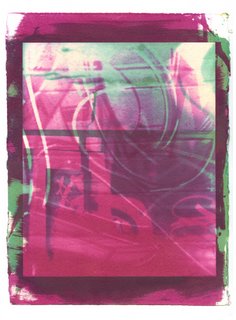graffiti transformation









The original walls are painted into a new setting which both documents and transforms the vernacular language of street graffiti. This is a response to an actual site through formal transformation. Progression, transition, and transformation are evoked through shifts in color, which are evolving through sequential panels.
The gum bichromate process is a symbiosis of photographic negatives and watercolor pigments on a textured paper surface. Additive layering is intrinsic to this medium. It is a simultaneous process of integrated layers which relate to and blend with each other. In this series, I painted with photography to construct form. I layered several colors and graffiti forms on the same page to “paint” form and color.
These studies undertake the reinterpretation of a graffiti wall and its translation through a new medium of form generation. The translation involves the original nature of graffiti—painted, layered shapes cut out of a sequential wall mural and reframed onto new pages. The process stems from the reinterpretation of the original place and creates an object in its own image and with its own values. The layering of abstracted, decontextualized forms responds to the nature of graffiti as a layered, painted surface which exists on an outside wall. As this is an additive process of layers, it also responds to graffiti artists layering on top of existing graffiti, sometimes obfuscating the images below with their own imagery.
I enjoy painting, but not painting on a blank surface. I want my project to be a documentation and transformation of a particular place. This photographic painting mixes existing images into new mediums which comment on the original materials. The iterative addition of layers to construct a new surface which directly is derived from an actual place is a transformative response to existing content and interests me in the possibilities of interpretation.
The graffiti fragments, completely abstracted from their original context, construct a new wall of color and form. The abstracted forms of graffiti construct new canvases of lines and shapes. The original wall mural has been reconfigured into a new medium to study overlap and juxtaposition and gestural form. The structure of the page is ordered by rectangular geometry. The panels are not organic, and even the random blotches have a strong geometric structure in their framing and juxtaposition. An organic medium—amorphous watercolor paint—is kept structured through strong horizontal lines of the masonry walls. The swaths of color, brush strokes, paint drips and blotches are some of the details that continue to evoke their original context. They ground the abstracted panels with some structure and semblance of the concrete block walls where the graffiti had been painted.
The same several negatives were used in this reconfigured kit of parts. With different colors and different assemblages of the same negative, different space is created. This assemblage of like parts that only differ in the configuration and color mixing allows the space of the page to be altered, depending on how the eye perceives color. The transparency allows the areas of overlap to create new colors. For example, the pink and the green overlaps create purple. As a result of this “inbetween” area of overlap, the colored forms have added a new dimension on the page with the third space they build. The point of intersection takes on significance as a real layering of physical colors. The colors of the transition and overlaps are the new inbetween colors, physically made up of two other colors. Here the additive layering process actually constructs something new, and has a purpose for its juxtaposition. The pairings and juxtapositions exist on the same page changing each other through their proximities.
The prints utilize both subtle and vibrant color juxtapositions, playing with different hues but similar values, as well as more garishly high contrast oppositions. The brighter colors speak to the bright graffiti originals, while the more subtle colors create a blending and shifting of the perceived space.
The sequence and progression of the abstracted forms is grounded in its exhibition format. I pinned up the individual pages in one row on the gallery wall to reconstruct a new photographic linear wall. Progression, transition, and transformation are evoked through the shifts in color, which are evolving through the sequential the panels. The story exists in the transitions between the panels, as they are meant to viewed in a sequence in which the colors are slowly transforming and turning. The magenta and hunter greens give way to the teals and cyans, over the course of the transition. The gestures of paint and surface slowly evolve over the course of the sequenced pages.
<< Home